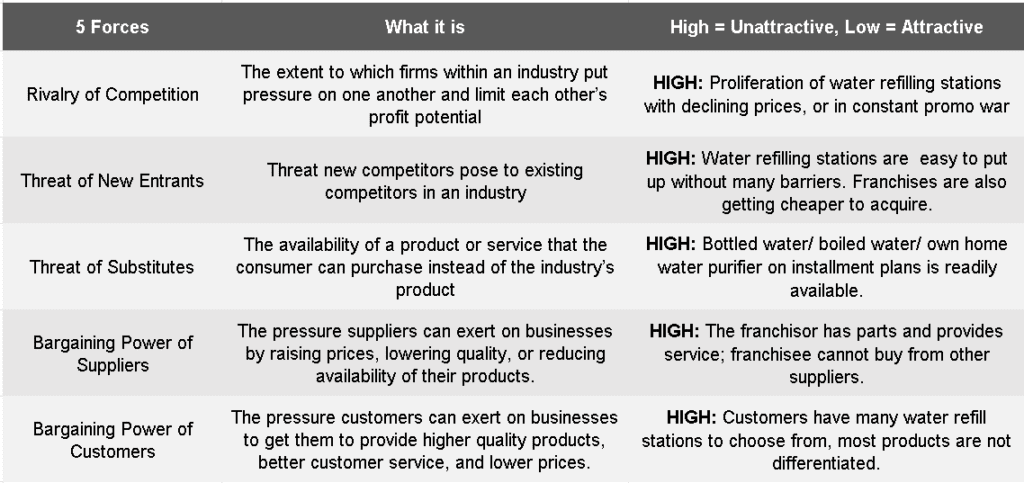
Water refill stations are being franchised everywhere. These water stations provide a low-cost alternative to expensive bottled water in the supermarkets. Filipinos have shifted from boiling their drinking water at home to simply buying from these water refill stations. Many provide delivery service even if a “suki” (loyal customer) orders only one five-gallon bottle, which is the standard used in these stations. But does one know if franchising a water refill station is attractive or not? The industry analysis framework introduced by Harvard professor Michael Porter can give an indicator, by analyzing the five forces in an industry – rivalry of competition, bargaining power of suppliers, threat of new entrants, threat of substitutes, bargaining power of customers, as shown in the table below. Note that the first three forces are about competition, both direct and indirect.
The five forces enable firms to identify competitive pressures (those with high threat) as well as opportunities in the marketplace. The force that has the most impact in the industry (rated “high”) of the firm should be watched closely with one’s corporate and marketing strategy formulated to counter the pressure accordingly. The framework is unique because profit is affected not just by competitive activities but also by the extent of bargaining power of suppliers and customers.
In the analysis of the water refill station, the five forces of industry are pointing to an industry generally unattractive to franchisees, unless there are a lot of resources for credit terms or for free use of hot/cold dispensers, or being a monopoly or being an early entrant in a geographical area. It is therefore important to carefully choose an industry that is attractive to invest in to get a better return on investment.
Table: The 5 Forces of Water Refill Station Franchising (Source: Entrepreneurship: The Four-Gate Model by Josiah Go, Chiqui Escareal-Go, and Calel Gosingtian)

It is important for aspiring entrepreneurs to choose an industry with friendlier economics. For instance, the pharmaceutical industry has a much higher return and demand versus investing in cable TV that is already affected with strong substitutes like Netflix. However, care should be exercised when using the industry analysis model, it is possible that an industry may not be as good upon initial evaluation, but a firm can introduce innovation and create better profitability for themselves. Some water refill stations sell a twin package with a laundry franchise since the water from water refill stations using reverse osmosis system throw out most of the water, with the wastage going to the laundry franchise.
The famous Bounty Fresh chicken case in the Philippines where a dressed chicken integrator decided to expand their business model to include thousands of Chooks- to-Go kiosks should be a reminder that there is no bad or inferior industry. Entrepreneurs who see opportunities in crisis have the edge, as competitors typically would not invest in (what may seem to be) an unattractive industry.
***.
Josiah Go is chair and chief innovation strategist of Mansmith and Fielders Inc. He is co-author of the book Entrepreneurship: The Four-Gate Model (with Chiqui Escareal-Go, and Calel Gosingtian) officially endorsed by GoNegosyo and JCI Manila.


